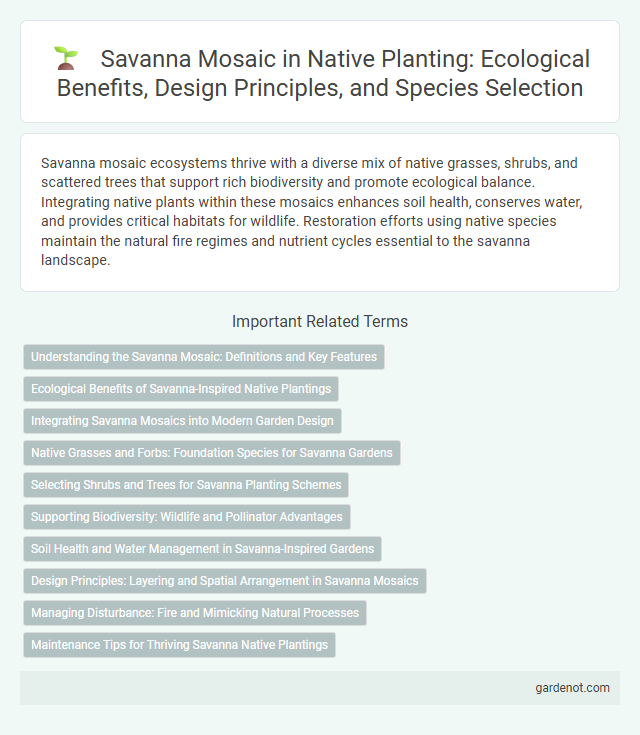Savanna mosaic ecosystems thrive with a diverse mix of native grasses, shrubs, and scattered trees that support rich biodiversity and promote ecological balance. Integrating native plants within these mosaics enhances soil health, conserves water, and provides critical habitats for wildlife. Restoration efforts using native species maintain the natural fire regimes and nutrient cycles essential to the savanna landscape.
Understanding the Savanna Mosaic: Definitions and Key Features
Savanna mosaic refers to a landscape characterized by a patchwork of grasslands interspersed with clusters of trees and shrubs, creating diverse habitats that support a rich variety of native species. Key features include seasonal rainfall patterns, nutrient-poor soils, and frequent fire regimes that shape vegetation structure and promote biodiversity. Understanding these ecological dynamics is essential for effective native planting and conservation strategies in savanna ecosystems.
Ecological Benefits of Savanna-Inspired Native Plantings
Savanna mosaic plantings, characterized by diverse native grasses, shrubs, and scattered trees, enhance soil health by preventing erosion and promoting nutrient cycling. These plantings support a wide range of pollinators and wildlife, contributing to biodiversity and ecosystem stability. The deep root systems of native species improve water infiltration and resilience against drought, making savanna-inspired landscapes vital for sustainable habitat restoration.
Integrating Savanna Mosaics into Modern Garden Design
Integrating savanna mosaics into modern garden design enhances biodiversity by incorporating native grasses, wildflowers, and scattered trees that mimic natural savanna ecosystems. This approach supports pollinators, improves soil health through deep-rooted plants, and creates visually dynamic landscapes that blend ecological functionality with aesthetic appeal. Using savanna mosaics also promotes sustainable water management by reducing irrigation needs and providing habitat connectivity for local wildlife.
Native Grasses and Forbs: Foundation Species for Savanna Gardens
Native grasses and forbs serve as foundation species in savanna mosaics, crucial for maintaining biodiversity and ecosystem function. These plants support soil health, provide habitat for pollinators, and stabilize the microclimate, fostering a resilient savanna garden environment. Selecting region-specific native species enhances ecological balance, promoting sustainable growth and native wildlife attraction.
Selecting Shrubs and Trees for Savanna Planting Schemes
Selecting shrubs and trees for savanna planting schemes involves prioritizing species that tolerate periodic drought and fire while supporting local biodiversity. Common choices include native oaks (Quercus spp.), hickories (Carya spp.), and understory shrubs like Amelanchier and Rhus, which provide essential habitat and food resources. Incorporating a mix of deep-rooted trees and fire-resistant shrubs enhances ecosystem resilience and promotes natural successional processes within the savanna mosaic.
Supporting Biodiversity: Wildlife and Pollinator Advantages
Savanna mosaic ecosystems provide critical habitats for diverse wildlife, fostering high biodiversity through a mix of native grasses, shrubs, and scattered trees. These landscapes support numerous pollinators such as bees, butterflies, and birds by offering varied floral resources throughout the year. The structural diversity in savanna mosaics enhances nesting sites and foraging opportunities, boosting pollinator populations and overall ecosystem resilience.
Soil Health and Water Management in Savanna-Inspired Gardens
Savanna mosaic gardens enhance soil health by promoting deep-rooted native grasses and wildflowers that improve soil structure and increase organic matter, fostering microbial activity essential for nutrient cycling. Efficient water management is achieved through the use of drought-tolerant species adapted to periodic dry spells, reducing irrigation needs while maximizing natural rainfall infiltration. Implementing mulching with native plant materials further conserves soil moisture and prevents erosion, creating a resilient savanna-inspired garden ecosystem.
Design Principles: Layering and Spatial Arrangement in Savanna Mosaics
Savanna mosaic design principles emphasize strategic layering of native grasses, shrubs, and trees to mimic natural stratification, enhancing biodiversity and ecosystem resilience. Spatial arrangement focuses on creating patchy distributions and diverse microhabitats, promoting species coexistence and adaptive resource use. These methods optimize habitat connectivity and ecological function within the savanna landscape.
Managing Disturbance: Fire and Mimicking Natural Processes
Savanna mosaic ecosystems rely on periodic fire disturbances to maintain biodiversity and prevent woody plant encroachment, mimicking natural fire regimes is essential for habitat health. Controlled burns regulate nutrient cycling and promote growth of native grasses and forbs while suppressing invasive species. Effective fire management practices enhance ecological resilience, supporting native plant diversity and ecosystem functionality.
Maintenance Tips for Thriving Savanna Native Plantings
Savanna native plantings thrive with regular maintenance practices such as controlled burns, which mimic natural fire cycles essential for nutrient recycling and invasive species control. Periodic removal of non-native plants prevents competition, ensuring native species access to resources and promoting biodiversity. Monitoring soil moisture and adjusting watering schedules help sustain plant health during dry spells, supporting the longevity of the savanna mosaic ecosystem.
Savanna mosaic Infographic

 gardenot.com
gardenot.com